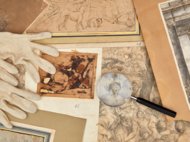
Decay, Loss, and Conservation in Art History
For centuries, Western artworks have been cared for in the hope of preserving them for as long as possible. Even so, over their lives objects deteriorate and risk being displaced, damaged, or destroyed – whether incidentally or on purpose. This inescapable fragility of artworks raises questions for those invested in them. How do communities safeguard endangered objects? And how do art historians study images that are no longer extant, or investigate artistic traditions where no material legacy has been preserved intact? Our group addresses these questions theoretically, historically, and materially to tackle how the inherent instability of objects shapes the way we handle, think, and write about them.
The Research Group is led by Francesca Borgo and funded by the Max Planck Society’s flagship Lise Meitner Excellence Program. The group’s approach moves emphasis away from the original state of the artwork. We analyze instead how objects transform over time and the ways in which they find new form, whether as fragments, ruins, or waste. By foregrounding what has long been considered an endpoint in art historical studies, we intend to overcome some of the discipline’s biases: that the moment of creation is the moment that matters, that the original condition of the artwork is the most important one, that display rather than storage is the site of art historical significance, and that material survival alone is what shapes the historical record. We ask what it would mean to write a history of art that celebrates maintenance as much as it does innovation.
We are interested not only in historicizing these issues by asking how people in the past contended with objects’ material lives but also in reflecting on how art history as a discipline addresses today’s ethics and politics of care. Our focus is on European and colonial art histories from the fifteenth to the eighteenth century, a period during which techniques and media were ranked based on their ability to last and decay was first recognized as a subject worthy of aesthetic and scientific attention. By probing a tradition that has always equated durability with value, the project promotes engagement with the vulnerability of artworks and a deeper understanding of the mechanics of decay and loss.
In recent years, conservation has emerged as one of the central issues of our time, inextricably entangled with climate change, armed conflict, the rise of new materials and technologies, and the post-colonial reckoning of museums grappling with looting and restitution debates. But conservation is also a space of profound social, racial and economic inequality, and the choices made about which stories to tell and which objects to preserve are not neutral. By bringing awareness to gaps in art historical narratives, we aim to highlight the impact of loss and erasure on the construction of the art historical canon and on other exclusionary practices of the discipline.
Working collaboratively, the project bridges art history, conservation, and museum and heritage studies to investigate how communities interact with their past – and what they choose to take from it into the future.
If your research aligns with our interests, please email Editorial-LMG@biblhertz.it. We are always happy to hear from people in the field, and we take applications on a rolling basis.




